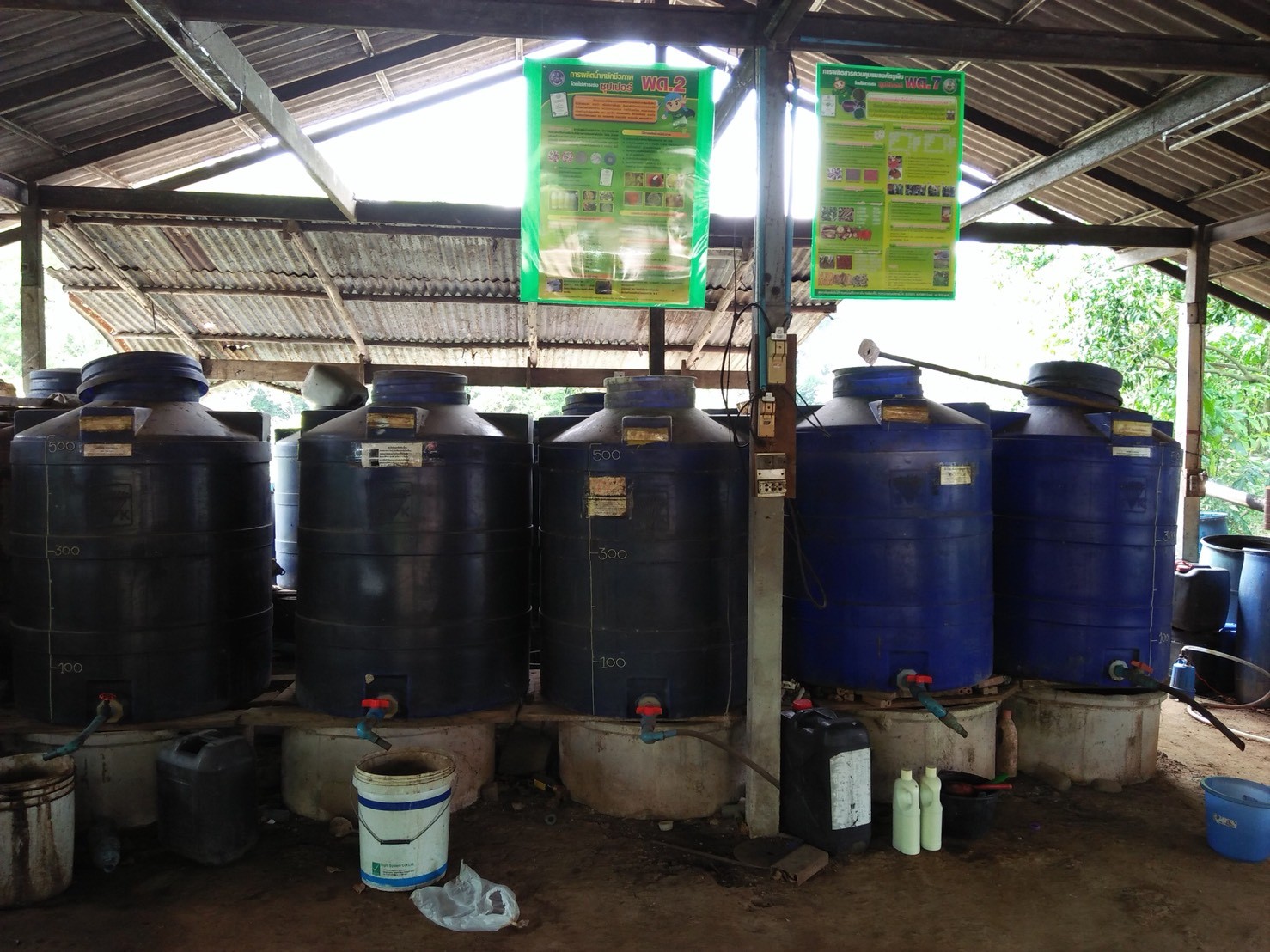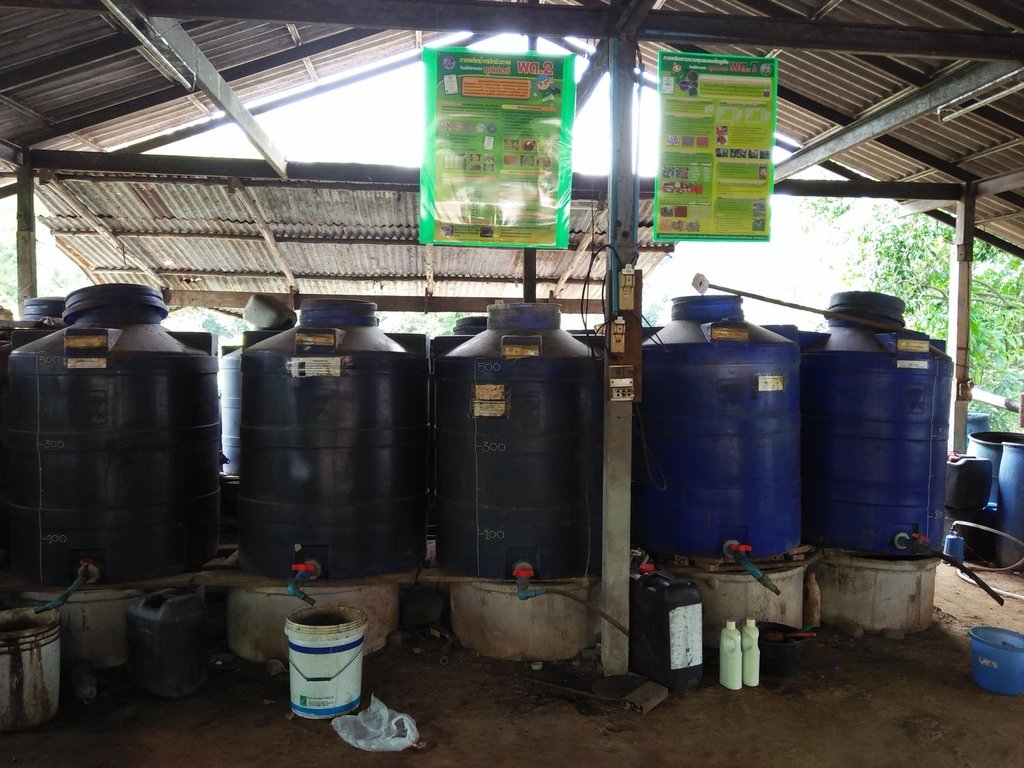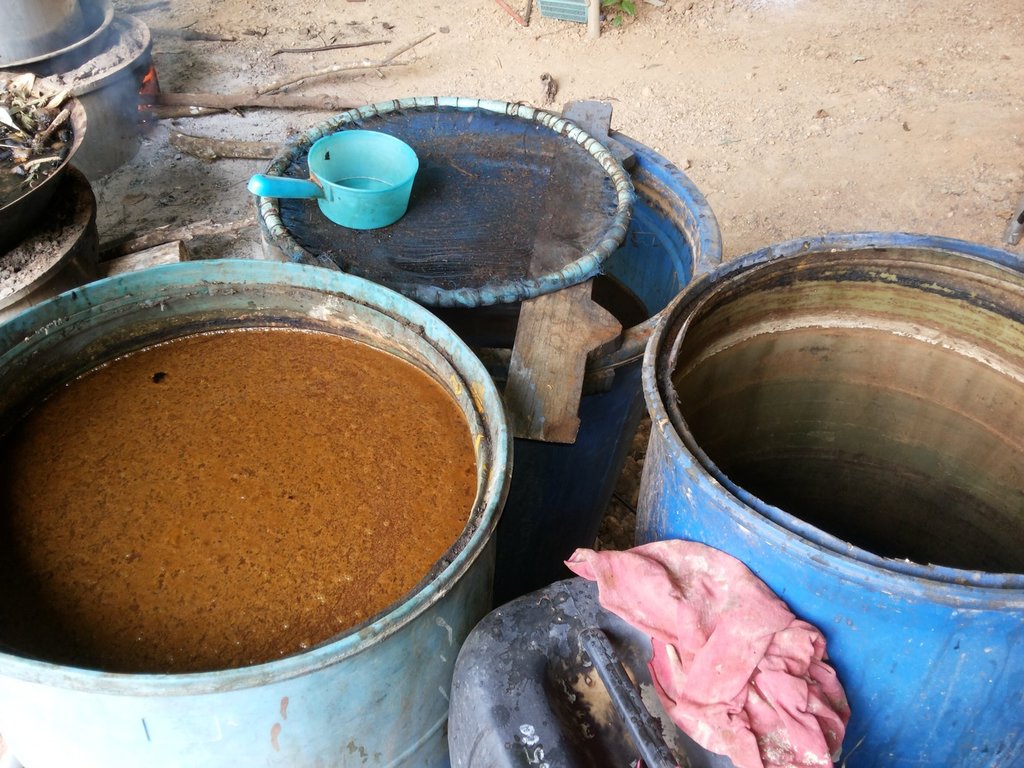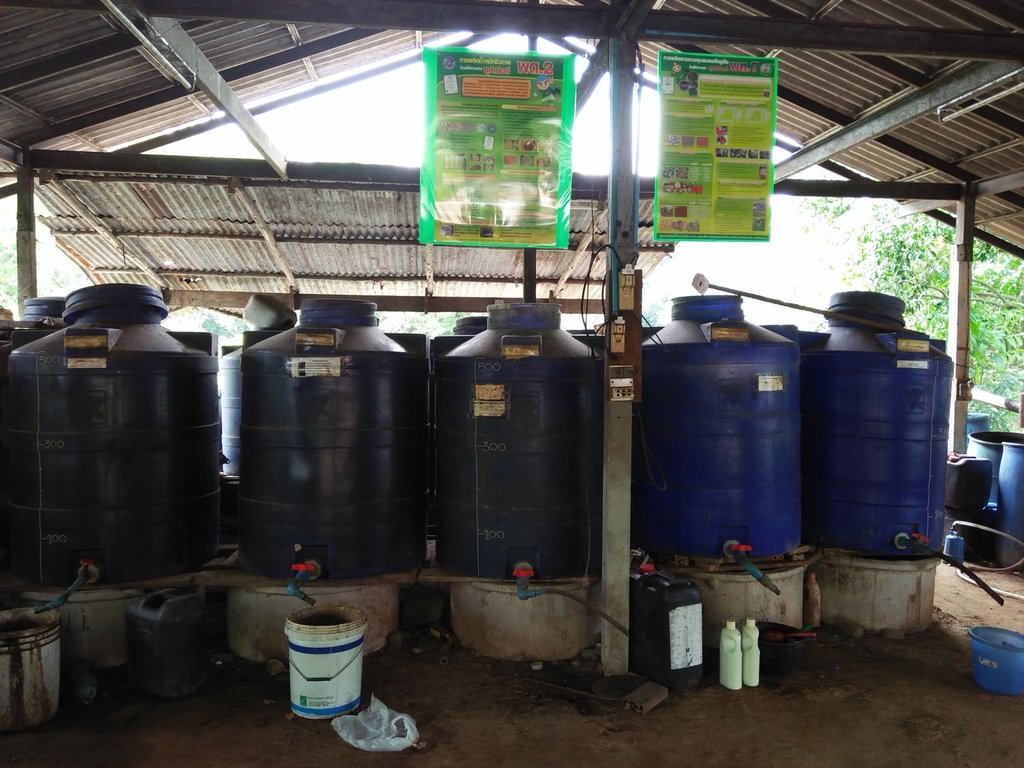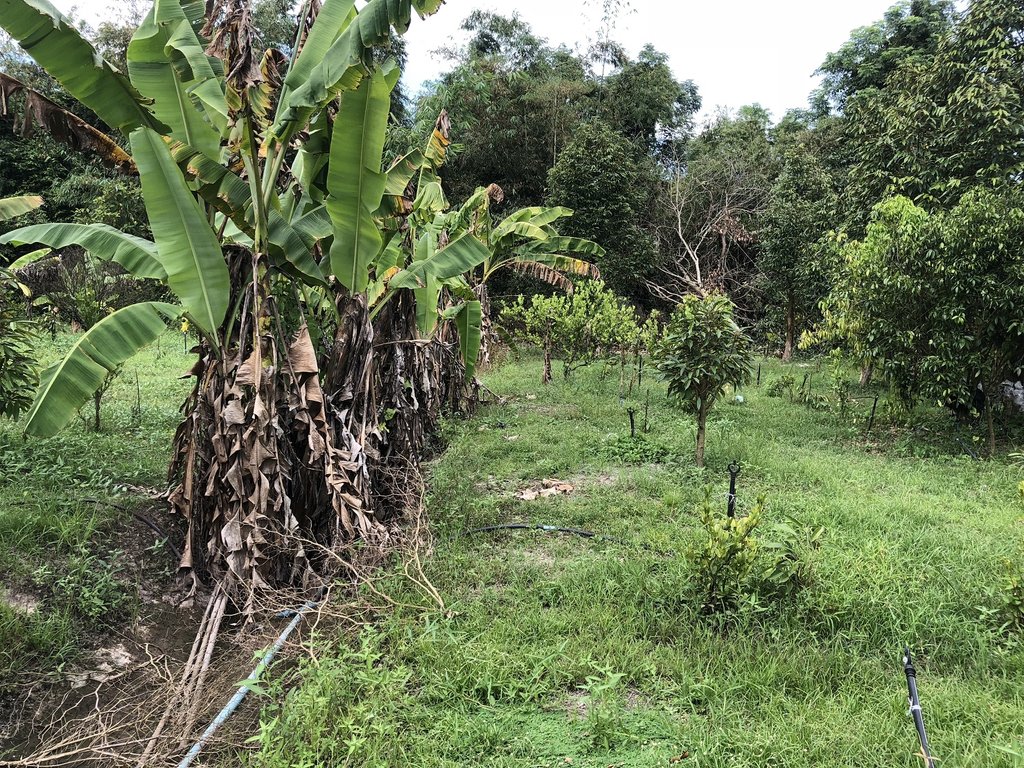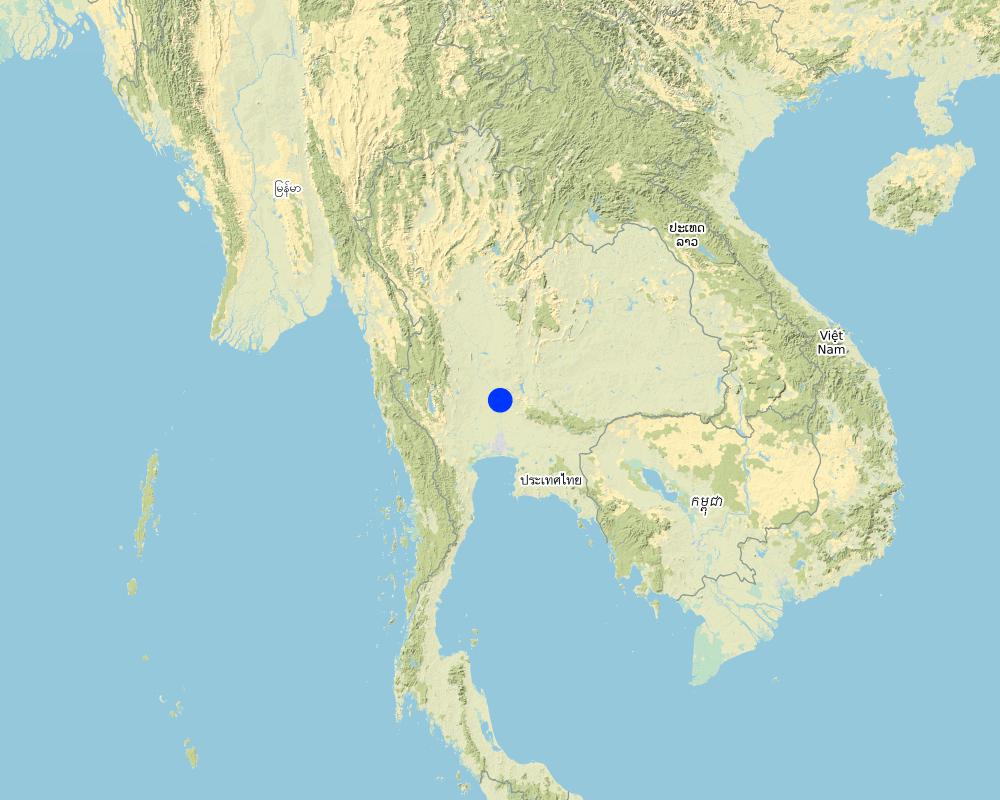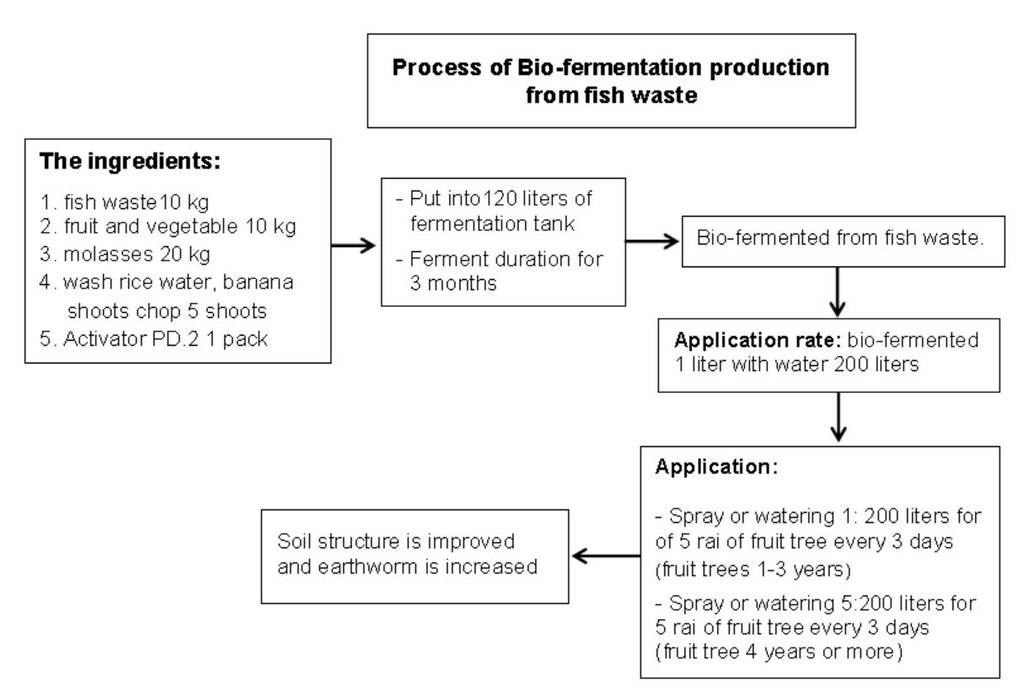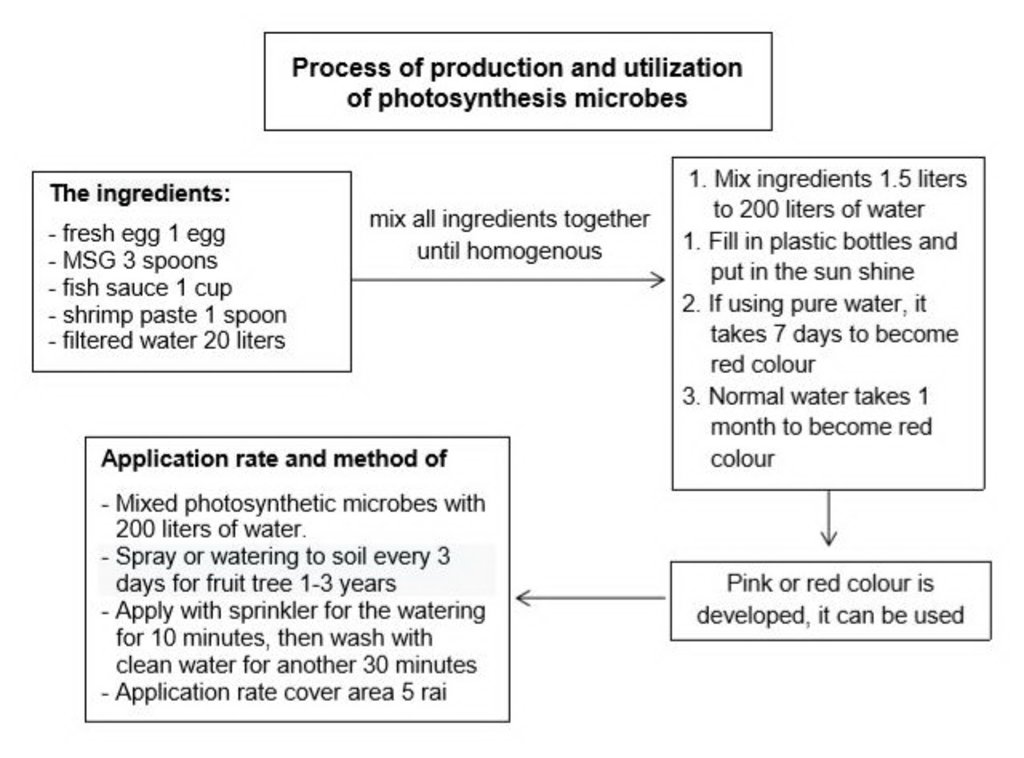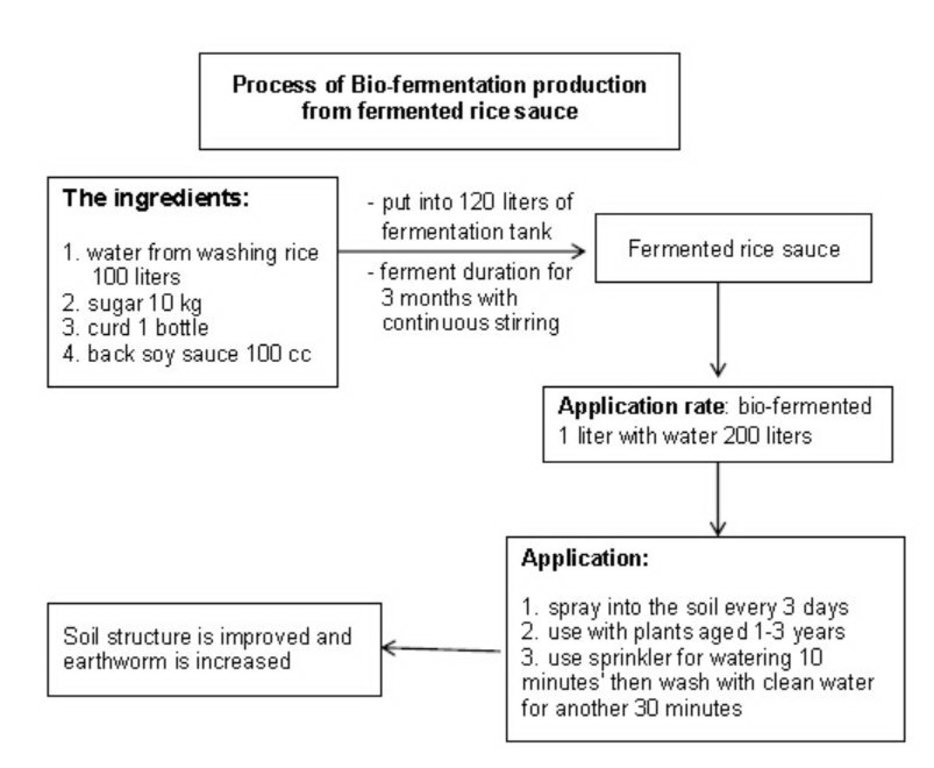Bio-fermentation technology for soil improvement
- Création :
- Mise à jour :
- Compilateur : Kukiat SOITONG
- Rédacteur : –
- Examinateurs : Rima Mekdaschi Studer, William Critchley
Num Mak She Wa Parp
technologies_4233
Voir les sections
Développer tout Réduire tout1. Informations générales
1.2 Coordonnées des personnes-ressources et des institutions impliquées dans l'évaluation et la documentation de la Technologie
Personne(s)-ressource(s) clé(s)
Spécialiste GDT:
ผู้รวบรวม:
ดุรงค์กาญจน์ นายสาโรช
สถานีพัฒนาที่ดินปราจีนบุรี สำนักงานพัฒนาที่ดินเขต 2 กรมพัฒนาที่ดิน
Thaïlande
exploitant des terres:
สนลอย นางวันเพ็ญ
เกษตรกร และหมอดินอาสาประจำจังหวัดปราจีนบุรี กรมพัฒนาที่ดิน
Thaïlande
Spécialiste GDT:
สนลอย นางวันเพ็ญ
เกษตรกร และหมอดินอาสาประจำจังหวัดปราจีนบุรี กรมพัฒนาที่ดิน
Thaïlande
Spécialiste GDT:
สนลอย นางวันเพ็ญ
เกษตรกร และหมอดินอาสาประจำจังหวัดปราจีนบุรี กรมพัฒนาที่ดิน
Thaïlande
1.3 Conditions relatives à l'utilisation par WOCAT des données documentées
Le compilateur et la(les) personne(s) ressource(s) acceptent les conditions relatives à l'utilisation par WOCAT des données documentées:
Oui
1.4 Déclaration sur la durabilité de la Technologie décrite
Est-ce que la Technologie décrite ici pose problème par rapport à la dégradation des terres, de telle sorte qu'elle ne peut pas être déclarée comme étant une technologie de gestion durable des terres?
Non
Commentaires:
การใช้เทคโนโลยีชีวภาพในพื้นที่ดินค่อนข้างเป็นทราย เสื่อมโทรม ช่วยปรับปรุงโครงสร้างดิน เพิ่มจุลินทรีย์ในดิน ทำให้ดินร่วนซุย ช่วยลดการใช้สารเคมี และช่วยรักษาสิ่งแวดล้อม
2. Description de la Technologie de GDT
2.1 Courte description de la Technologie
Définition de la Technologie:
Bio-fermentation technology for soil improvement is an alternative technology that helps to restore degraded land from intensive land usage which lack of soil improvement to get back to be the soil productivity that can provide effective production.
2.2 Description détaillée de la Technologie
Description:
The area has chemical and physical degradation problems. The area is the lowland. The soil is quite sandy. The soil structure is poor which the draining system is quite bad. The organic matter, soil nutrients and soil fertility is low.
Farmers use the land to grow rice but have the low rice yield. Farmers have changed their rice fields to grow their crops instead.
Which changing the area from the normal rice field by digging the ditch for 1 meter wide on growing area, 1 meter wide for the drain and 0.80 meters deep)that grow durian, banana, lime, vegetable (Climbing Wattle)
The weed management by using chemicals and chemical fertilizers in the high rate continuously to make the soil degrade or dense and grow the ineffective crops.
Bio-fermentation technology for soil improvement consists of the production of 3 types of biological fermentation and the usage of 3 types of biological fermentation as follows:
1. Product Processions of bio-fermented water
The methods of the 3 types bio-fermented producing are as follows.
1.1 Production of bio-fermented from the fish fraction by using the Microbial Activators from LDD.
1.2. Production of photosynthetic microorganisms
1.3 Production of Bio-Fermented Water from rice flour water
2. How to use the bio-fermentation to improve the soil
Mix the three bio-nutrients at a rate of 1: 1: 1 per 200 litters of water and spray or pour on the ground every 3 days or use sprinkler system by releasing the bio-fermented water mix with water for 10 minutes followed and wash it with water for 3 minutes for 3 years (at the beginning of the growing season).
The usage of Bio-fermentation technology to improve the soil has the objective is to restore the degradation of agricultural land for a long term and using the high rate of chemical fertilizers continuously to be able to do the farm effectively.
The usage of Bio-fermentation technology to improve the soil has the important activities to do are following:
1. Product Processions of Bio-fermentation Solution
The methods of the 3 types bio-fermented producing are as follows.
1.1 Production of bio-fermented from the fish fraction by using the Microbial Activators PD2 by using the fish fraction about 10 kilograms, the fruit and vegetable fraction about 10 kilograms, molasses about 20 kilograms, the rice flour water or the banana fraction about 5 spire and the Microbial Activators PD 1 packet to mix everything in the tank size 120 litters for 3 months.
1.2. Production of photosynthetic microorganisms made by 5 eggs, 3 tablespoons of MSG, 1 tablespoon of fish sauce, 1 tablespoon of filtered water and 20 liters of pure water mixed in a homogeneous mixture at the rate of 1.5 liters per 200 liters of water for 7 days and it will be red (in case of using the pure water) and 1 month (in case of using clear water).
1.3 Production of bio-fermented solution from using 100 liter of rice flour water, 10 kilogram of sugar, 1 yakult bottle (curd) and 10 milliliters of fermented soy sauce in a 120 liters pot size fermentation tank for 3 months
2. The using steps of bio-fermented solution to improve the soil to improve the soil in the crop land for the different periods of cultivation as follows.
2.1. The early stage before the production period (1-3 years)
Mix the three types ofBio-fermentation solution at a rate of 1: 1: 1 per 200 litters of water and spray or pour on the ground every 3 days or use sprinkler system to release the bio-fermented water for 10 minutes and use the clear water later for 30 minutes
2.2 The yield period (more than 4 years)
To dissolve the bio-fermented which from the fish for 5 liters: 200 liters of water and spray or pour on the ground every 3 days or use sprinkler system to release the bio-fermented water for 10 minutes, followed by 30 minutes of the clear water.
1. Make the soil more fertile, organic matter and microorganisms in soil (earthworm). The benefits of nutrients in the soil increase. It can grow durian which can be sold at high prices (180 baht / tree).
2. Reduce the plant production costs due to using the waste materials from the land to be the fermentation materials. The farmers have increased income, lives are not dependent on themselves and the using the biotechnology does not have an impact on the environment.
1. This technology is the knowledge that is derived from experiential / practical experiments in the area of farmer prototype technology users which can see the real results from using it.
2. The methods / procedures are not complicated.
3. It is easy to use, not difficult mosquitoes.
4. There are multichannel technology has been released that the farmers can access it easily.
1. This technology (bio-fermentation / bio-extract) does not have any nutritional status checking which cannot be shown the quantity.
2. Farmers generally lack of the motivation to do and use.
2.3 Photos de la Technologie
2.4 Vidéos de la Technologie
Commentaire, brève description:
การใช้เทคโนโลยีชีวภาพเพื่อการพัฒนาที่ดิน
Date:
07/03/2018
Nom du vidéaste:
กรมพัฒนาที่ดิน
2.5 Pays/ région/ lieux où la Technologie a été appliquée et qui sont couverts par cette évaluation
Région/ Etat/ Province:
ภาคตะวันออก/จังหวัดปราจีนบุรี
Autres spécifications du lieu:
62/1 หมู่ 5 ตำบลไม้เค็ด อำเภอเมือง จังหวัดปราจีนบุรี
Map
×2.6 Date de mise en œuvre de la Technologie
Indiquez l'année de mise en œuvre:
1997
Si l'année précise est inconnue, indiquez la date approximative: :
- il y a entre 10-50 ans
2.7 Introduction de la Technologie
Spécifiez comment la Technologie a été introduite: :
- grâce à l'innovation d'exploitants des terres
3. Classification de la Technologie de GDT
3.1 Principal(aux) objectif(s) de la Technologie
- améliorer la production
- réduire, prévenir, restaurer les terres dégradées
- préserver l'écosystème
- conserver/ améliorer la biodiversité
3.2 Type(s) actuel(s) d'utilisation des terres, là où la Technologie est appliquée

Terres cultivées
- Plantations d’arbres ou de buissons
- การปลูกพืชผสมผสาน
Nombre de période de croissance par an: :
- 2
Précisez:
-
Commentaires:
-
3.3 Est-ce que l’utilisation des terres a changé en raison de la mise en œuvre de la Technologie ?
Commentaires:
-
3.4 Approvisionnement en eau
Approvisionnement en eau des terres sur lesquelles est appliquée la Technologie:
- pluvial
Commentaires:
-
3.5 Groupe de GDT auquel appartient la Technologie
- gestion intégrée de la fertilité des sols
- lutte intégrée contre les ravageurs et les maladies (incluant l'agriculture biologique)
3.6 Mesures de GDT constituant la Technologie

autres mesures
Précisez:
others การผลิตและการใช้น้ำหมักชีวภาพ
Commentaires:
มีการทำเกษตรแบบผสมผสานทั้งไม้ผลและพืชผักสวนครัว
3.7 Principaux types de dégradation des terres traités par la Technologie

dégradation chimique des sols
- Cn: baisse de la fertilité des sols et réduction du niveau de matière organique (non causée par l’érosion)

dégradation physique des sols
- Pc: compaction

dégradation biologique
- Bl: perte de la vie des sols
Commentaires:
เกิดจากการใช้ปุ๋ยเคมีมากเกินความจำเป็น เกินความต้องการของพืชต่อเนื่อง เป็นระยะเวลานาน ทำให้ดินเสื่อมโทรม
3.8 Prévention, réduction de la dégradation ou réhabilitation des terres dégradées
Spécifiez l'objectif de la Technologie au regard de la dégradation des terres:
- réduire la dégradation des terres
- restaurer/ réhabiliter des terres sévèrement dégradées
Commentaires:
การใช้ปุ๋ยเคมีต่อเนื่องเป็นระยะเวลานาน ทำให้สมบัติทางเคมีและชีวภาพของดิน เสื่อมโทรมลง จำเป็นต้องได้รับการฟื้นฟู
4. Spécifications techniques, activités, intrants et coûts de mise en œuvre
4.1 Dessin technique de la Technologie
Spécifications techniques (associées au dessin technique):
1.กระบวนการผลิต น้ำหมักชีวภาพ
วิธีการผลิตน้ำหมักชีวภาพ 3 สูตร มีดังนี้
1.1 การผลิตน้ำหมักชีวภาพจากเศษปลาด้วยสารเร่ง พด 2 ผลิตโดยใช้ เศษปลา 10 กก. เศษผัก/ผลไม้ 10 กก. กากน้ำตาล 20 กก. น้ำซาวข้าว/หน่อกล้วยสับ 5 หน่อ และสารเร่ง พด.2 1 ซอง หมักในถังหมักขนาด 120 ลิตร นาน 3 เดือน
2. วิธีการใช้น้ำหมักชีวภาพเพื่อปรับปรุงบำรุงดิน
ให้นำน้ำหมักชีวภาพทั้งสามสูตรผสมกันในอัตรา1:1:1 ต่อน้ำ200 ลิตร ฉีดพ่นหรือรดลงดินทุกๆ 3 วัน หรือใช้ระบบสปริงเกอร์ โดยปล่อยน้ำหมักชีวภาพไปกับน้ำ 10 นาที ตามด้วยการล้างด้วยน้ำเปล่าอีก 30 นาที เป็นเวลา 3 ปี (ช่วงเริ่มต้นของการปลูกปลูกไม้ผล
Auteur:
นายสาโรช ดุรงค์กาญจน์
Date:
02/10/2018
Spécifications techniques (associées au dessin technique):
1.2.การผลิตจุลินทรีย์สังเคราะห์แสง ผลิตโดยใช้ส่วนผลมไข่ไก่ ผงชูรส 3 ช้อนโต๊ะ น้ำปลา 1 แก้ว กะปิ 1 ช้อนโต๊ะ และน้ำกรองสะอาด 20 ลิตร ผสมจนเป็นเนื้อเดียวกัน ผสมนำในอัตรา 1.5 ลิตร ต่อน้ำ 200 ลิตร กรอกใส่ขวดพลาสติกใส วางตากแดด ใช้เวลา 7 วัน จะเกิดสีแดง (ในกรณีที่ใช้น้ำบริสุทธิ์) และใช้เวลา 1 เดือน (ในกรณีใช้น้ำประปาทั่วไป)
2. วิธีการใช้น้ำหมักชีวภาพเพื่อปรับปรุงบำรุงดิน
ให้นำน้ำหมักชีวภาพทั้งสามสูตรผสมกันในอัตรา1:1:1 ต่อน้ำ200 ลิตร ฉีดพ่นหรือรดลงดินทุกๆ 3 วัน หรือใช้ระบบสปริงเกอร์ โดยปล่อยน้ำหมักชีวภาพไปกับน้ำ 10 นาที ตามด้วยการล้างด้วยน้ำเปล่าอีก 30 นาที เป็นเวลา 3 ปี (ช่วงเริ่มต้นของการปลูกปลูกไม้ผล
Auteur:
นายสาโรช ดุรงค์กาญจน์
Date:
02/10/2018
Spécifications techniques (associées au dessin technique):
1.3 การผลิตน้ำหมักชีวภาพจาก น้ำซาวข้าว ผลิตโดยใช้ น้ำซาวข้าว 100 ลิตร น้ำตาลทราย 10 กก. ยาคูลท์ 1 ขวด และซีอิ๊วดำ 10 มล. หมักในถังหมักขนาด 120 ลิตร นาน 3 เดือน
2. วิธีการใช้น้ำหมักชีวภาพเพื่อปรับปรุงบำรุงดิน
ให้นำน้ำหมักชีวภาพทั้งสามสูตรผสมกันในอัตรา1:1:1 ต่อน้ำ200 ลิตร ฉีดพ่นหรือรดลงดินทุกๆ 3 วัน หรือใช้ระบบสปริงเกอร์ โดยปล่อยน้ำหมักชีวภาพไปกับน้ำ 10 นาที ตามด้วยการล้างด้วยน้ำเปล่าอีก 30 นาที เป็นเวลา 3 ปี (ช่วงเริ่มต้นของการปลูกปลูกไม้ผล
Auteur:
นายสาโรช ดุรงค์กาญจน์
Date:
02/10/2018
Spécifications techniques (associées au dessin technique):
1.3 การผลิตน้ำหมักชีวภาพจาก น้ำซาวข้าว ผลิตโดยใช้ น้ำซาวข้าว 100 ลิตร น้ำตาลทราย 10 กก. ยาคูลท์ 1 ขวด และซีอิ๊วดำ 10 มล. หมักในถังหมักขนาด 120 ลิตร นาน 3 เดือน
2. วิธีการใช้น้ำหมักชีวภาพเพื่อปรับปรุงบำรุงดิน
ให้นำน้ำหมักชีวภาพทั้งสามสูตรผสมกันในอัตรา1:1:1 ต่อน้ำ200 ลิตร ฉีดพ่นหรือรดลงดินทุกๆ 3 วัน หรือใช้ระบบสปริงเกอร์ โดยปล่อยน้ำหมักชีวภาพไปกับน้ำ 10 นาที ตามด้วยการล้างด้วยน้ำเปล่าอีก 30 นาที เป็นเวลา 3 ปี (ช่วงเริ่มต้นของการปลูกปลูกไม้ผล
Auteur:
นายสาโรช ดุรงค์กาญจน์
4.2 Informations générales sur le calcul des intrants et des coûts
Spécifiez la manière dont les coûts et les intrants ont été calculés:
- par superficie de la Technologie
Indiquez la taille et l'unité de surface:
1 ไร่
Si vous utilisez une unité de superficie locale, indiquez le facteur de conversion vers un hectare (p.ex. 1 ha = 2.47 acres): 1 ha = :
-
autre/ monnaie nationale (précisez):
Thai Baht
Indiquez le taux de change des USD en devise locale, le cas échéant (p.ex. 1 USD = 79.9 réal brésilien): 1 USD = :
32,0
Indiquez le coût salarial moyen de la main d'œuvre par jour:
แรงงานต่อวันคือ 300 บาท
4.3 Activités de mise en place/ d'établissement
| Activité | Calendrier des activités (saisonnier) | |
|---|---|---|
| 1. | กระบวนการผลิตน้ำหมักชีวภาพ | - |
| 2. | วิธีการใช้น้ำหมักชีวภาพ | - |
Commentaires:
เป็นการใช้เทคโนโลยีระหว่างการบำรุงและดูแลไม้ผลก่อนเก็บเกี่ยวผลผลิต
4.4 Coûts et intrants nécessaires à la mise en place
| Spécifiez les intrants | Unité | Quantité | Coûts par unité | Coût total par intrant | % des coût supporté par les exploitants des terres | |
|---|---|---|---|---|---|---|
| Main d'œuvre | จ้างผลิตน้ำหมักชีวภาพพด.2,จุลินทรีย์สังเคราะห์แสงน้ำหมักชีวภาพน้ำซาวข้าว | คน | 2,0 | 300,0 | 600,0 | 100,0 |
| Main d'œuvre | ต่อท่อน้ำสปริงเกอร์ | คน | 2,0 | 300,0 | 600,0 | 100,0 |
| Equipements | ท่อน้ำและข้อต่อ | ตัว | 50,0 | 40,0 | 2000,0 | 100,0 |
| Equipements | ปั๊มน้ำ | ปั๊ม | 1,0 | 8000,0 | 8000,0 | 100,0 |
| Engrais et biocides | ถังหมัก | ใบ | 3,0 | 500,0 | 1500,0 | 80,0 |
| Engrais et biocides | กากน้ำตาล | ลิตร | 120,0 | 12,0 | 1440,0 | 80,0 |
| Engrais et biocides | เศษปลา/เศษผักผลไม้Waste | กิโลกรัม | 40,0 | 10,0 | 400,0 | 100,0 |
| Engrais et biocides | ผงชูรส/กะปิ/ไข่/Yakult/ซีอิ๋ว/น้ำตาลทราย | - | 1,0 | 100,0 | 100,0 | 100,0 |
| Engrais et biocides | สารเร่วพด2 | ซอง | 1,0 | 14,0 | 14,0 | 100,0 |
| Coût total de mise en place de la Technologie | 14654,0 | |||||
| Coût total de mise en place de la Technologie en dollars américains (USD) | 457,94 | |||||
Si le coût n'est pas pris en charge à 100% par l'exploitant des terres, indiquez qui a financé le coût restant:
สถานีพัฒนาที่ดินปราจีนบุรี
Commentaires:
สถานีพัฒนาที่ดินสนับสนุนปัจจัยการผลิต ได้แก่ ถังหมัก กากน้ำตาล และเชื้อจุลินทรีย์สารเร่ง พด.2
4.5 Activités d'entretien/ récurrentes
| Activité | Calendrier/ fréquence | |
|---|---|---|
| 1. | 1. การใช้น้ำหมักชีวภาพ | สัปดาห์ละ1ครั้ง |
| 2. | 2. การผลิตน้ำหมักชีวภาพ | 3 เดือน/ครั้ง |
Commentaires:
เป็นการดูแลรักษาเครื่องมือ เช่น ข้อต่อ หัวฉีด ไม่ให้อุดตัน
4.6 Coûts et intrants nécessaires aux activités d'entretien/ récurrentes (par an)
| Spécifiez les intrants | Unité | Quantité | Coûts par unité | Coût total par intrant | % des coût supporté par les exploitants des terres | |
|---|---|---|---|---|---|---|
| Main d'œuvre | จ้างผลิตน้ำหมักชีวภาพพด.2,จุลินทรีย์สังเคราะห์แสง,น้ำหมักชีวภาพน้ำซาวข้าว | คน | 4,0 | 300,0 | 1200,0 | 100,0 |
| Equipements | ท่อน้ำและข้อต่อ | ตัว | 50,0 | 40,0 | 2000,0 | 100,0 |
| Engrais et biocides | กากน้ำตาล | ลิตร | 120,0 | 12,0 | 1440,0 | 80,0 |
| Engrais et biocides | เศษปลา/เศษผักผลไม้Waste | กิโลกรัม | 40,0 | 10,0 | 400,0 | 100,0 |
| Engrais et biocides | ผงชูรส/กะปิ/ไข่/Yakult/ซีอิ๋ว/น้ำตาลทราย | กิโลกรัม | 1,0 | 100,0 | 100,0 | 100,0 |
| Engrais et biocides | สารเร่วพด2 | ซอง | 1,0 | 14,0 | 14,0 | |
| Coût total d'entretien de la Technologie | 5154,0 | |||||
| Coût total d'entretien de la Technologie en dollars américains (USD) | 161,06 | |||||
Si le coût n'est pas pris en charge à 100% par l'exploitant des terres, indiquez qui a financé le coût restant:
-
Commentaires:
เป็นค่ารักษาซ่อมแซมในกรณีที่ชำรุดเสียหาย
4.7 Facteurs les plus importants affectant les coûts
Décrivez les facteurs les plus importants affectant les coûts :
ราคาวัตถุดิบในการผลิคน้ำหมักชีวภาพ เช่นกากน้ำตาล
5. Environnement naturel et humain
5.1 Climat
Précipitations annuelles
- < 250 mm
- 251-500 mm
- 501-750 mm
- 751-1000 mm
- 1001-1500 mm
- 1501-2000 mm
- 2001-3000 mm
- 3001-4000 mm
- > 4000 mm
Spécifications/ commentaires sur les précipitations:
-
Indiquez le nom de la station météorologique de référence considérée:
-
Zone agro-climatique
- humide
-
5.2 Topographie
Pentes moyennes:
- plat (0-2 %)
- faible (3-5%)
- modéré (6-10%)
- onduleux (11-15%)
- vallonné (16-30%)
- raide (31-60%)
- très raide (>60%)
Reliefs:
- plateaux/ plaines
- crêtes
- flancs/ pentes de montagne
- flancs/ pentes de colline
- piémonts/ glacis (bas de pente)
- fonds de vallée/bas-fonds
Zones altitudinales:
- 0-100 m
- 101-500 m
- 501-1000 m
- 1001-1500 m
- 1501-2000 m
- 2001-2500 m
- 2501-3000 m
- 3001-4000 m
- > 4000 m
Indiquez si la Technologie est spécifiquement appliquée dans des:
- non pertinent
Commentaires et précisions supplémentaires sur la topographie:
-
5.3 Sols
Profondeur moyenne du sol:
- très superficiel (0-20 cm)
- superficiel (21-50 cm)
- modérément profond (51-80 cm)
- profond (81-120 cm)
- très profond (>120 cm)
Texture du sol (de la couche arable):
- grossier/ léger (sablonneux)
Texture du sol (> 20 cm sous la surface):
- grossier/ léger (sablonneux)
Matière organique de la couche arable:
- faible (<1%)
Si disponible, joignez une description complète du sol ou précisez les informations disponibles, par ex., type de sol, pH/ acidité du sol, capacité d'échange cationique, azote, salinité, etc.
-
5.4 Disponibilité et qualité de l'eau
Profondeur estimée de l’eau dans le sol:
5-50 m
Disponibilité de l’eau de surface:
moyenne
Qualité de l’eau (non traitée):
uniquement pour usage agricole (irrigation)
La salinité de l'eau est-elle un problème? :
Non
La zone est-elle inondée?
Oui
Commentaires et précisions supplémentaires sur la qualité et la quantité d'eau:
คุณภาพน้ำดีสามารถนำมาใช้ทางการเกษตรได้ แต่ยังไม่เหมาะสำหรับการดื่มกินต้องได้รับบำบัดก่อนจึงจะนำมาบริโภคได้
5.5 Biodiversité
Diversité des espèces:
- élevé
Diversité des habitats:
- moyenne
Commentaires et précisions supplémentaires sur la biodiversité:
เนื่องจากมีการปลูกพืชหลายชนิด เช่น ทุเรียน ลองกอง ส้มโอ มะนาว ถั่ว ชะอม ทำให้มีความหลากหลายทางพันธุกรรมพืชสูง ส่วนแหล่งที่อยู่อาศัยมีไม่มากทำให้มีความหลากหลายในระดับปานกลาง
5.6 Caractéristiques des exploitants des terres appliquant la Technologie
Sédentaire ou nomade:
- Sédentaire
Orientation du système de production:
- exploitation mixte (de subsistance/ commerciale)
Revenus hors exploitation:
- moins de 10% de tous les revenus
Niveau relatif de richesse:
- riche
Individus ou groupes:
- individu/ ménage
Niveau de mécanisation:
- travail manuel
Genre:
- femmes
Age des exploitants des terres:
- personnes âgées
Indiquez toute autre caractéristique pertinente des exploitants des terres:
-
5.7 Superficie moyenne des terres utilisées par les exploitants des terres appliquant la Technologie
- < 0,5 ha
- 0,5-1 ha
- 1-2 ha
- 2-5 ha
- 5-15 ha
- 15-50 ha
- 50-100 ha
- 100-500 ha
- 500-1 000 ha
- 1 000-10 000 ha
- > 10 000 ha
Cette superficie est-elle considérée comme de petite, moyenne ou grande dimension (en se référant au contexte local)?
- moyenne dimension
Commentaires:
เนื่องจากเป็นการประเมินราคาที่ดินในเขตเมือง
5.8 Propriété foncière, droits d’utilisation des terres et de l'eau
Propriété foncière:
- individu, avec titre de propriété
Droits d’utilisation des terres:
- individuel
Droits d’utilisation de l’eau:
- accès libre (non organisé)
Précisez:
สิทธิในการใช้น้ำเป็นแบบเปิดเนื่องจากเป็นประปาของชุมชนไม่มีระเบียบว่าอย่างไรแต่เสียค่าใช้จ่ายตามปริมาณใช้จริงและส่วนใหญ่การใช้น้ำในพื้นที่มาจากบ่อของตนเองเป็นหลัก
5.9 Accès aux services et aux infrastructures
santé:
- pauvre
- modéré
- bonne
éducation:
- pauvre
- modéré
- bonne
assistance technique:
- pauvre
- modéré
- bonne
emploi (par ex. hors exploitation):
- pauvre
- modéré
- bonne
marchés:
- pauvre
- modéré
- bonne
énergie:
- pauvre
- modéré
- bonne
routes et transports:
- pauvre
- modéré
- bonne
eau potable et assainissement:
- pauvre
- modéré
- bonne
services financiers:
- pauvre
- modéré
- bonne
Commentaires:
-
6. Impacts et conclusions
6.1 Impacts sur site que la Technologie a montrés
Impacts socio-économiques
Production
production agricole
Quantité avant la GDT:
10
Quantité après la GDT:
30
Commentaires/ spécifiez:
ผลทุเรียนเพิ่มขึ้น
qualité des cultures
Commentaires/ spécifiez:
-
Revenus et coûts
dépenses pour les intrants agricoles
Commentaires/ spécifiez:
ปัจจัยบางอย่างนามาใช้ในปีถัดไปได้ เช่น ถังหมัก
revenus agricoles
Commentaires/ spécifiez:
รายได้จากการจำหน่ายต้นพันธุ์ และผลทุเรียน
Impacts socioculturels
sécurité alimentaire/ autosuffisance
Commentaires/ spécifiez:
ดีขึ้นสามารถพึ่งพาตนเองได้
situation sanitaire
droits d'utilisation des terres/ de l'eau
institutions communautaires
Commentaires/ spécifiez:
สถาบันครอบครัว
connaissances sur la GDT/ dégradation des terres
Commentaires/ spécifiez:
ดินมีอินทรีย์วัตถุเพิ่มขึ้น โครงสร้างดินดีขึ้น
Impacts écologiques
Cycle de l'eau/ ruissellement
qualité de l'eau
Commentaires/ spécifiez:
ลดการปนเปื้อนเนื่องจากเป็นการใช้สารอินทรีย์ ลดการใช้สารเคมี
ruissellement de surface
nappes phréatiques/ aquifères
Sols
humidité du sol
couverture du sol
Commentaires/ spécifiez:
มีหญ้าปกคลุมมีไส้เดือน
perte en sol
encroûtement/ battance du sol
Commentaires/ spécifiez:
ดินร่วนซุยขึ้น
compaction du sol
cycle/ recharge des éléments nutritifs
acidité
Quantité avant la GDT:
4.0-4.5
Quantité après la GDT:
5.5-6.0
Commentaires/ spécifiez:
pH เพิ่มขึ้น
Biodiversité: végétale, animale
diversité végétale
espèces bénéfiques
Commentaires/ spécifiez:
ไส้เดือนเพิ่มขึ้น
contrôle des animaux nuisibles/ maladies
Commentaires/ spécifiez:
ลดลง
Réduction des risques de catastrophe et des risques climatiques
impacts des inondations
6.2 Impacts hors site que la Technologie a montrés
disponibilité de l'eau
pollution des rivières/ nappes phréatiques
Commentaires/ spécifiez:
ลดลงเนื่องจากลดการใช้สารเคมี
dommages sur les infrastructures publiques/ privées
6.3 Exposition et sensibilité de la Technologie aux changements progressifs et aux évènements extrêmes/catastrophes liés au climat (telles que perçues par les exploitants des terres)
Changements climatiques progressifs
Changements climatiques progressifs
| Saison | Augmentation ou diminution | Comment la Technologie fait-elle face à cela? | |
|---|---|---|---|
| températures annuelles | augmente | modérément | |
| températures saisonnières | été | augmente | pas bien |
| précipitations annuelles | augmente | modérément | |
| précipitations saisonnières | saison des pluies/ humide | augmente | pas bien |
Extrêmes climatiques (catastrophes)
Catastrophes hydrologiques
| Comment la Technologie fait-elle face à cela? | |
|---|---|
| crue éclair | modérément |
Commentaires:
ปีนี้ฝนประจำปีมาเร็วขึ้นทำให้ผลไม้ติดผลลดลงเนื่องจากฝนตกลงมาช่วงออกดอก
6.4 Analyse coûts-bénéfices
Quels sont les bénéfices comparativement aux coûts de mise en place (du point de vue des exploitants des terres)?
Rentabilité à court terme:
positive
Rentabilité à long terme:
très positive
Quels sont les bénéfices comparativement aux coûts d'entretien récurrents (du point de vue des exploitants des terres)?
Rentabilité à court terme:
neutre / équilibrée
Rentabilité à long terme:
très positive
Commentaires:
คิดเห็น การทำน้ำหมักและการวางระบบกระจายน้ำในแปลงจะเป็นการลงทุนในปีแรกที่สูงแต่ในปีถัดไปค่าใช้จ่ายจะลดลงเพราะไม่ได้ซื้อเพิ่ม เช่น ถังหมัก ท่อน้ำ ปั๊มน้ำ มีแต่ค่าดูแลรักษาเวลาชำรุด เสียหาย เช่น ท่อน้ำแตก อุดตัน และมีระยะเวลาการใช้ ประมาณ 4-5 ปี
6.5 Adoption de la Technologie
- 1-10%
Si disponible, quantifiez (nombre de ménages et/ou superficie couverte):
เฉพาะอำเภอเมือง จังหวัดปราจีนบุรี
De tous ceux qui ont adopté la Technologie, combien d'entre eux l'ont fait spontanément, à savoir sans recevoir aucune incitation matérielle, ou aucune rémunération? :
- 0-10%
Commentaires:
ประมาณจากจำนวนผู้ได้รับการถ่ายทอดเทคโนโลยีที่เข้ามาศึกษาที่ศูนย์เรียนรู้
6.6 Adaptation
La Technologie a-t-elle été récemment modifiée pour s'adapter à l'évolution des conditions?
Oui
Si oui, indiquez à quel changement la Technologie s'est adaptée:
- évolution des marchés
Spécifiez l'adaptation de la Technologie (conception, matériaux/ espèces, etc.):
ความต้องการสินค้าเกษตรปลอดภัยหรือเกษตรอินทรีย์มีเพิ่มขึ้น ทำให้เทคโนโลยีสามารถปรับตัวให้เข้ากับสภาพการเปลี่ยนแปลงที่เกิดขึ้นได้
6.7 Points forts/ avantages/ possibilités de la Technologie
| Points forts/ avantages/ possibilités du point de vue de l'exploitant des terres |
|---|
| มีองค์ความรู้จากผู้ปฏิบัติจริง/เห็นผลจริง |
| เทคโนโลยีนี้เผยแพร่หลายช่องทาง |
| มีสถานที่และอุปกรณ์พร้อมในการเผยแพร่ |
| มีองค์ความรู้จากผู้ปฏิบัติจริง/เห็นผลจริง |
| Points forts/ avantages/ possibilités du point de vue du compilateur ou d'une autre personne ressource clé |
|---|
| วิธีการ/ขั้นตอนการผลิตไม่ยุ่งยากซับซ้อน |
| วิธีการใช้ นำไปใช้ได้ง่าย สะดวกไม่ยุงยาก |
| - |
6.8 Faiblesses/ inconvénients/ risques de la Technologie et moyens de les surmonter
| Faiblesses/ inconvénients/ risques du point de vue de l’exploitant des terres | Comment peuvent-ils être surmontés? |
|---|---|
| ไม่ทราบปริมาณธาตุอาหารพืชในน้ำหมัก | ให้มีกาตรวจวิเคราะห์ |
| Faiblesses/ inconvénients/ risques du point de vue du compilateur ou d'une autre personne ressource clé | Comment peuvent-ils être surmontés? |
|---|---|
| เกษตรกรยังขาดแรงจูงใจในการทำ | ให้เกษตรกรเห็นว่าลดต้นทุนได้อย่างไร ส่งผลดีต่อพืชอย่างไร |
|
การใช้เทคโนโลยีนี้ เเกษตรกรที่จะปฏิบัติตามต้องมีความเชื่อมั่น ขยันและอดทน...เนื่องจากต้องใช้เวล าในการพิสูจน์ให้เก็นผลจากการใช้ |
รัฐและเกษตรกรต้องร่วมมือกันสร้างความเชื่อมั่นให้แก่เกษตรกร ด้วยการให้ความรู้ และเผยแพร่ |
7. Références et liens
7.1 Méthodes/ sources d'information
- visites de terrain, enquêtes sur le terrain
5 ราย
- interviews/entretiens avec les exploitants des terres
5 ราย
Quand les données ont-elles été compilées (sur le terrain)?
10/10/2018
Commentaires:
-
7.2 Références des publications disponibles
Titre, auteur, année, ISBN:
-
Disponible à partir d'où? Coût?
-
7.3 Liens vers les informations pertinentes en ligne
Titre/ description:
-
URL:
-
7.4 Observations d'ordre général
-
Liens et modules
Développer tout Réduire toutLiens
Aucun lien
Modules
Aucun module trouvé


